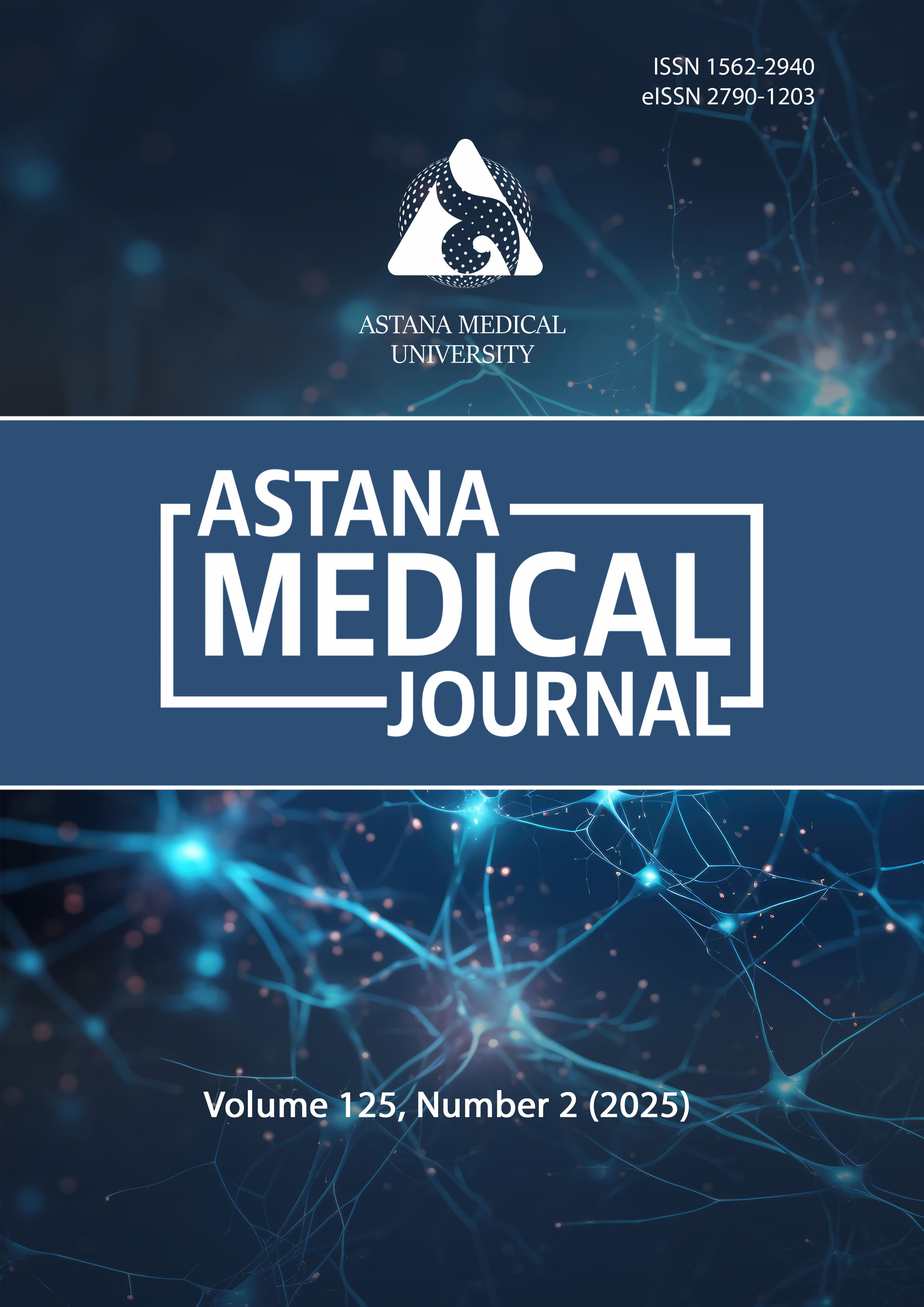Распространенность факторов сердечно-сосудистого риска среди молодой популяции Республики Казахстан
Ключевые слова:
факторы риска, артериальное давление, молодое население, ожирение, избыточный вес, курение, малоподвижный образ жизниАннотация
Сердечно-сосудистые заболевания - основная причина инвалидности и смертности в мире, и их распространённость продолжает расти. Важное внимание уделяется не только лечению, но и профилактике ССЗ, таких как артериальная гипертония и ишемическая болезнь сердца. Изучение значимых факторов кардиоваскулярного риска, включая модифицируемые, позволяет снизить бремя этих заболеваний. Однако для Казахстана важно определить, какие факторы риска наиболее значимы.
Цель исследования. Оценить распространенность и значимость факторов кардиоваскулярного риска среди молодого населения Казахстана.
Методы. Обследованы 4140 молодых людей в возрасте 18–44 лет. Использовались анкеты, включавшие вопросы о факторах риска и коморбидности. Артериальное давление и пульс измерялись трижды в соответствии с рекомендациями Европейского общества гипертонии.
Результаты. Средний возраст участников - 31,6±7,4 года (95% ДИ 31,4–31,9). Средний ИМТ - 24,7±4,7 (95% ДИ 24,5–24,8). Средний пульс - 79,1±10,5. Курение отмечают 50,3%, злоупотребление алкоголем - 24,4%, малоподвижный образ жизни - 43,5%.
Выводы. Исследование подчеркивает необходимость скрининга и повышения осведомленности о факторах кардиоваскулярного риска для их эффективной профилактики.
Скачивания
Библиографические ссылки
Roth, G. A., Mensah, G. A., Johnson, C. O., Addolorato, G., Ammirati, E., Baddour, L. M., GBD-NHLBI-JACC Global Burden
of Cardiovascular Diseases Writing Group. (2020). Global burden of cardiovascular diseases and risk factors, 1990–2019:
update from the GBD 2019 study. Journal of the American college of cardiology, 76(25), 2982-3021. https://doi.org/10.1016/j.jacc.2020.11.010
Vasan, R. S., Zachariah, J. P., Xanthakis, V. (2020). Life course developmental approach to cardiovascular health and
cardiovascular disease prevention: opportunities and unanswered questions. Journal of the American College of Cardiology, 76(23), 2708-2711. https://doi.org/10.1016/j.jacc.2020.10.011
Perak, A. M., Ning, H., Khan, S. S., Bundy, J. D., Allen, N. B., Lewis, C. E., Lloyd-Jones, D. M. (2020). Associations of late
adolescent or young adult cardiovascular health with premature cardiovascular disease and mortality. Journal of the American College of Cardiology, 76(23), 2695-2707. https://doi.org/10.1016/j.jacc.2020.10.002
Yang, J., Biery, D. W., Singh, A., Divakaran, S., DeFilippis, E. M., Wu, W. Y., Blankstein, R. (2020). Risk factors and outcomes
of very young adults who experience myocardial infarction: the partners YOUNG-MI registry. The American journal of medicine, 133(5), 605-612. https://doi.org/10.1016/j.amjmed.2019.10.020
Jha, P., Ramasundarahettige, C., Landsman, V., Rostron, B., Thun, M., Anderson, R. N., Peto, R. (2013). 21st-century
hazards of smoking and benefits of cessation in the United States. New England Journal of Medicine, 368(4), 341-350. https://doi.org/10.1056/NEJMsa1211128
Muntner, P., Hardy, S. T., Fine, L. J., Jaeger, B. C., Wozniak, G., Levitan, E. B., Colantonio, L. D. (2020). Trends in blood
pressure control among US adults with hypertension, 1999-2000 to 2017-2018. Jama, 324(12), 1190-1200. https://doi.org/10.1001/jama.2020.14545
Aggarwal, R., Yeh, R. W., Maddox, K. E. J., Wadhera, R. K. (2023). Cardiovascular risk factor prevalence, treatment, and
control in US adults aged 20 to 44 years, 2009 to March 2020. Jama, 329(11), 899-909. https://doi.org/10.1001/jama.2023.2307
Drozdz, D., Alvarez-Pitti, J., Wójcik, M., Borghi, C., Gabbianelli, R., Mazur, A., Wühl, E. (2021). Obesity and cardiometabolic
risk factors: from childhood to adulthood. Nutrients, 13(11), 4176. https://www.mdpi.com/2072-6643/13/11/4176#
World Health Organization. Obesity and overweight. Website. [Cited 1 March 2024]. Available from URL: https://
www.who.int/news-room/fact-sheets/detail/obesity-and-overweight
Dipietro, L., Zhang, Y., Mavredes, M., Simmens, S. J., Whiteley, J. A., Hayman, L. L., Napolitano, M. A. (2020). Physical
activity and cardiometabolic risk factor clustering in young adults with obesity. Medicine and science in sports and exercise,
(5), 1050. https://doi.org/10.1249/MSS.0000000000002214
Usha, S. M. R., Chandrika, N., Shetty, H. V., Reena, R. (2014). A study of the components of metabolic syndrome in young
adults. Biomedical Research, 25(1), 45-50. https://hero.epa.gov/hero/index.cfm/reference/details/reference_id/6327705
Devers, M. C., Campbell, S., Simmons, D. (2016). Influence of age on the prevalence and components of the metabolic
syndrome and the association with cardiovascular disease. BMJ Open Diabetes Research and Care, 4(1), e000195. https://doi.org/10.1136/bmjdrc-2016-000195
Sumner, A. D., Sardi, G. L., Reed III, J. F. (2012). Components of the metabolic syndrome differ between young and
old adults in the US population. The Journal of Clinical Hypertension, 14(8), 502-506.
https://doi.org/10.1111/j.1751-7176.2012.00647.x
Shoelson, S. E., Lee, J., Goldfine, A. B. (2006). Inflammation and insulin resistance. The Journal of clinical investigation,
(7), 1793-1801. https://doi.org/10.1172/JCI29069
Ford, E. S. (2005). Risks for all-cause mortality, cardiovascular disease, and diabetes associated with the metabolic
syndrome: a summary of the evidence. Diabetes care, 28(7), 1769-1778. https://doi.org/10.2337/diacare.28.7.1769









